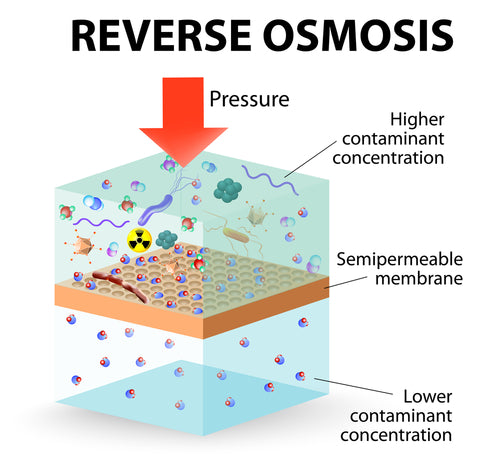
Jun 01 , 2017
Six Benefits of Using Reverse Osmosis Water Filters
Reverse Osmosis (RO) uses a membrane that filters out minuscule particulate matter from the water. Tiny holes in the membrane only permit H2O to pass through. The process exerts pressure on the water while forcing it through the holes, which removes the majority of the contaminants efficiently.
There are numerous benefits of using an RO water filter. Your clothes, dishes, and other things get much cleaner using water filtered by reverse osmosis. Better yet, there are important health benefits to using RO filtered water.
Here are six of the most significant benefits of having a reverse osmosis filtering system in your home.
#1 - RO Is Good for the Environment and Your Health
Reverse osmosis systems have many positive effects on the environment. If you use RO, you are less likely to buy bottled water and, hence, less likely to pollute the environment with plastic.
RO systems use a lot less energy than other filtration mechanisms. Power consumption is extremely small and the membrane construction very efficient.
If you use a multi-stage reverse osmosis system, your water will be virtually free of any/all harmful chemicals and particles.
No matter what sort of impurities your local water supply may have, RO can filter them out, providing you with a healthier source of drinking water. Reverse osmosis, according to medical research, is very safe for cancer patients to drink. Chemotherapy and radiation weaken the immune system of cancer victims. Water that has gone through reverse osmosis removes bacteria and other types of microorganismsnormally harmless, but which could cause potentially deadly infections in cancer patients.
#2 - Lead and Cryptosporidium-Free Water
The Center for Disease Control (CDC) states that using a reverse osmosis system removes lead from water. Lead has extremely detrimental effects on the body and has been directly linked to infertility, nerve damage, brain damage, severe anemia, and high blood pressure.
RO also removes Cryptosporidium parasites from your water. This parasite causes fever, diarrhea, and stomach cramps, especially in children.
#3 - Provides You with Several Levels of Purification
If you choose a reverse osmosis filter, the simple yet elegant system allows you to choose how many levels of filtration you want.
RO systems, depending on the model you choose, can provide up to seven filtration levels, each with finer and finer membrane filtration. Level 1 and Level 2 filtration occur prior to the water going through the RO membrane. Level 1 is a sediment filter that gets rid of dirt, silt, and other larger particulate matter affecting taste and appearance. Level 2 is a carbon filter. The activated carbon gets rid of material like chlorine, chloramines, and other chemicals.
The Level 3 puts the water through the RO membrane, removing organic and inorganic compounds like lead, parasitic cysts, copper, fluoride, and other materials.
The Level 4 removes any remaining total dissolved solids (TDS). The remaining levels continue to remove any/all contaminants from the water, including using ultraviolet (UV) in the 7th stage to kill virus and bacteria.
#4 Better Taste
The more chemicals and particulate matter removed from your water, the better it will taste. However, some people may need time to get used to the flavor. Many people get used to the taste of some of the minerals unfiltered water contains.
Depending on your desires, you may not need a 7-stage RO filter, as you may want to leave some of the minerals in the water.
#5 Cost Savings
Using water supplied through the city or a well to drink rather than buying bottled water will save you a lot of money. You can even consider buying reusable water bottles and take your RO filtered water with you to sports, the office, or whenever you are out and about.
RO systems require little maintenance compared to other systems. Typically, a reverse osmosis system requires you to replace the filter every six months. However, you may have to replace the filters sooner depending on how much contaminants your water contains.
#6 Sodium and Contaminant Removal
The adverse effects of too much sodium in your body are well documented. Too much sodium causes high blood pressure and kidney and liver problems. RO systems remove virtually all the sodium from your water.
Reverse osmosis gets rid of many other well-known particularly bad chemicals and materials, such as arsenic and other substances, which adversely affect your health.
Final Thoughts
Reverse osmosis is one of the most efficient filtering systems for your water on the market. These systems take up little space and require little maintenance.
If you want better-tasting healthier water in your home, you should consider a reverse osmosis system.


